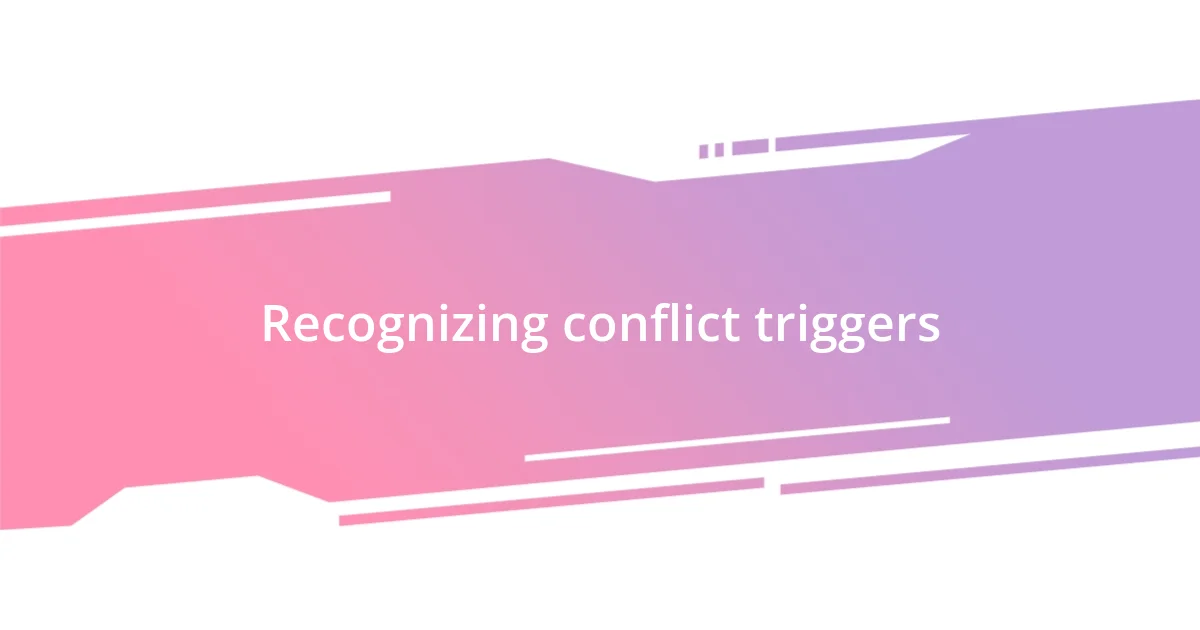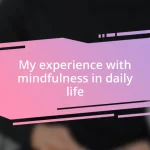Key takeaways:
- Family conflicts often arise from misunderstandings and unresolved issues, highlighting the importance of recognizing triggers and emotional reactions.
- Effective communication strategies, such as active listening and using “I” statements, can foster understanding and shift conversations from conflict to collaboration.
- Seeking professional help can provide valuable insights and support in navigating family disputes, ultimately strengthening relationships through guided discussions.

Understanding family conflicts
Family conflicts often spring from misunderstandings or differing values. I remember a time when my sister and I had a huge disagreement over how to manage our parent’s care, each of us believing wholeheartedly that we had the right approach. It made me wonder, what drives those emotions that cause us to clash with our loved ones?
It’s fascinating how unresolved issues can bubble up during family gatherings, often catching everyone off guard. During a holiday dinner, a casual remark turned into a heated debate about finances, revealing deeper insecurities and old resentments. Isn’t it interesting how the dynamics of love and loyalty can twist into tension and strife within the same room?
Navigating these conflicts can be a complex emotional journey. I often find myself reflecting on how family loyalty sometimes clouds our judgment. When I finally acknowledged that these conflicts stemmed from love—albeit mixed with frustration—I found it easier to communicate. How can we learn to express our needs without tipping the scales into disagreement?

Recognizing conflict triggers
Recognizing the triggers of family conflict often requires deep introspection. I remember sitting at a family barbecue when a seemingly innocent joke about my career sparked an intense discussion. What surprised me was how a light-hearted moment quickly transformed into defensiveness; it made me realize that our backgrounds and past experiences shape our sensitivities—I saw how easily words could twist into weapons when touched on raw nerves.
As I gradually began to observe these patterns, I recognized that certain topics were like loaded guns, ready to explode at the slightest provocation. For example, when family dynamics surrounding parenting styles came up, I could feel my heart rate increase, recalling past disagreements. By pinpointing these triggers, I started framing conversations differently; I’d gently direct them towards shared experiences rather than divisive stances. Wasn’t it enlightening to see that by changing my approach, the conversations could shift from battlefields to bridges?
Taking note of how our emotions interact with conflict triggers has been a significant step in understanding my family’s disputes. I recall a time when discussing holiday plans led to a clash about traditions—my siblings felt strongly about keeping old customs alive while I advocated for new ones. It was through recognizing these deeply held beliefs that I learned to navigate around the triggers effectively, fostering a more open dialogue rather than a confrontation.
| Trigger | Emotional Reaction |
|---|---|
| Career-related comments | Defensiveness & frustration |
| Parenting style differences | Anxiety & anger |
| Holiday traditions | Resentment & disappointment |

Effective communication strategies
When it comes to effective communication in the midst of family conflicts, I’ve learned that active listening is a game changer. There was a particularly heated discussion about our parents’ living arrangements where, instead of interrupting or jumping to conclusions, I focused on truly absorbing my sister’s words. It was surprising to realize how often I had been formulating my response instead of understanding her perspective. When I finally practiced patience, it allowed for a more respectful exchange of views and less escalation.
To foster effective communication, consider these strategies:
- Listen deeply: Give full attention without planning your reply while the other person speaks.
- Use “I” statements: Express your feelings without placing blame (e.g., “I feel overwhelmed when…”).
- Stay calm: Take a breather if emotions are running high; it’s okay to take a pause.
- Avoid loaded language: Steer clear of absolutes like “always” or “never,” which can escalate tensions.
- Clarify intentions: Before responding, summarize what you’ve heard to ensure understanding.
Another essential strategy is to create a safe space for dialogue. One time, during a family gathering, I initiated a calm discussion about everyone’s worries concerning our parents’ care. I made a point to sit in a cozy, quiet corner of the house, which seemed to set the tone for a more reflective conversation. As we shared our thoughts, the atmosphere shifted from adversarial to collaborative, allowing us to brainstorm solutions rather than dwell on issues. It felt like a breakthrough—a sign that communication doesn’t have to be a battleground, but can instead be a platform for understanding and collaboration.

Setting boundaries with family
Setting boundaries with family can be incredibly challenging, yet it’s essential for maintaining healthy relationships. I remember one particular Christmas when I finally decided to express my need for a quiet, stress-free holiday. Instead of allowing the chaos of gift exchanges and loud conversations to overwhelm me, I shared my desire for small, intimate gatherings. Surprisingly, my family respected my boundary, and that one simple conversation changed the dynamics of our holiday traditions.
Thinking about boundaries often leads me back to an uncomfortable dinner where topics swirled so frantically that I felt dizzy. When family members started probing into my personal choices, I realized I had to assert my limits. I said, “I’d prefer not to discuss my life choices over dinner, can we talk about something else?” The room quieted, and I felt a wave of relief wash over me. It reinforced the idea that setting boundaries doesn’t mean shutting people out; rather, it opens the door for more meaningful interactions.
I’ve found that clarity plays a key role in setting boundaries—it’s not enough to simply express them; I need to be consistent in upholding them. For example, after maintaining my boundary about my career for several months, I noticed my family began to respect my privacy more. It made me wonder, have you ever experienced a similar transition? The journey of establishing boundaries has turned uncertain moments into respectful exchanges, allowing deeper connections to flourish among my loved ones.

Implementing conflict resolution techniques
When implementing conflict resolution techniques, I’ve discovered that broaching the subject with empathy can truly shift the dynamics. There was that moment during a family reunion when my cousin and I were at odds over differing opinions on parenting styles. Instead of diving into a debate, I chose to ask her how she arrived at her decisions. This simple inquiry not only diffused the tension but also opened the door for a fascinating conversation. Isn’t it incredible how curiosity can replace conflict?
I also believe that practicing forgiveness is vital in navigating family disputes. After a particularly heated argument over years of unspoken grievances, I made the choice to forgive—both myself and my family members. It was liberating! When I sat down with my brother, I expressed my feelings while also acknowledging his perspective. The weight lifted from our shoulders as we shared our experiences. Each of us had been holding onto resentment, but by addressing it openly, we found a common ground. Isn’t it freeing to let go of burdens we don’t even realize we’re carrying?
Moreover, I’ve learned that following up after a conflict can be just as important as the initial resolution. After a tense moment with my aunt about her comments on my career, I reached out a few days later with a heartfelt message. I acknowledged her intentions but expressed how her words affected me. That little gesture not only cleared up any misunderstandings but also reinforced our relationship. Have you ever checked in after a disagreement? You might be surprised by how much it helps in rebuilding those crucial family connections.

Seeking professional help if needed
Sometimes, navigating family conflicts can be overwhelming, and that’s when I realized seeking professional help could be a game-changer. I remember feeling stuck in a loop of arguments with my sibling, and despite our attempts to resolve things, we just kept falling back into old patterns. When we finally agreed to see a family therapist, it felt like the fog lifted. Having a neutral party guide our conversations added clarity and helped us see things from each other’s perspectives. Have you ever felt that moment when a little outside perspective shifts everything?
It’s essential to understand that seeking help doesn’t mean failure; instead, it shows a commitment to the relationship. I’ve encountered friends who feared judgment by family members for considering therapy, yet their breakthroughs were significant. Once, a close friend shared how therapy helped her navigate a longstanding rift with her parents. The insights she gained not only changed her perspective but also allowed her to approach family discussions with newfound confidence. Isn’t it fascinating how sometimes, outside guidance can provide the support we need to heal?
Even if engaging a professional feels daunting, I’ve learned that it can be a vital tool for growth. I suggest starting with an informal discussion about it with family members. I once suggested this to my family, and although there were mixed reactions, it opened a pathway to honest dialogue. Sometimes hearing current struggles, rather than past grievances, brought us closer. It made me wonder—what could you accomplish if you sought that professional insight?

Reflecting on personal growth
Reflecting on personal growth has truly been a journey. I remember a time when I found myself arguing with a family member, completely convinced that I was right. But stepping back, I started to realize that growth isn’t just about validation; it’s about understanding and adapting. Encountering that moment of humility was unexpected, but it taught me that sometimes, the strongest position is one of openness. Have you ever found yourself letting go of pride in the name of harmony?
As I navigated those tricky waters, I noticed how my perceptions shifted. Instead of expecting others to change for me, I began focusing on altering my own reactions. In one instance, I chose to write down my feelings before discussing them. This simple act not only calmed my nerves but also helped articulate my thoughts clearly. It was like unlocking a door to self-discovery. Isn’t it empowering to realize we can influence the atmosphere around us by simply re-evaluating our approach?
Looking back, I see how these experiences shaped my understanding of family dynamics. I’ve learned to cherish the lessons even in discomfort, and that realization alone was transformative. For instance, my late-night conversations with my dad about his childhood struggles opened my eyes to his experiences, making me appreciate who he is today. Reflecting on such moments reminds me that growth often sprouts from the soil of uncomfortable truths. Have you ever found wisdom in vulnerability?














